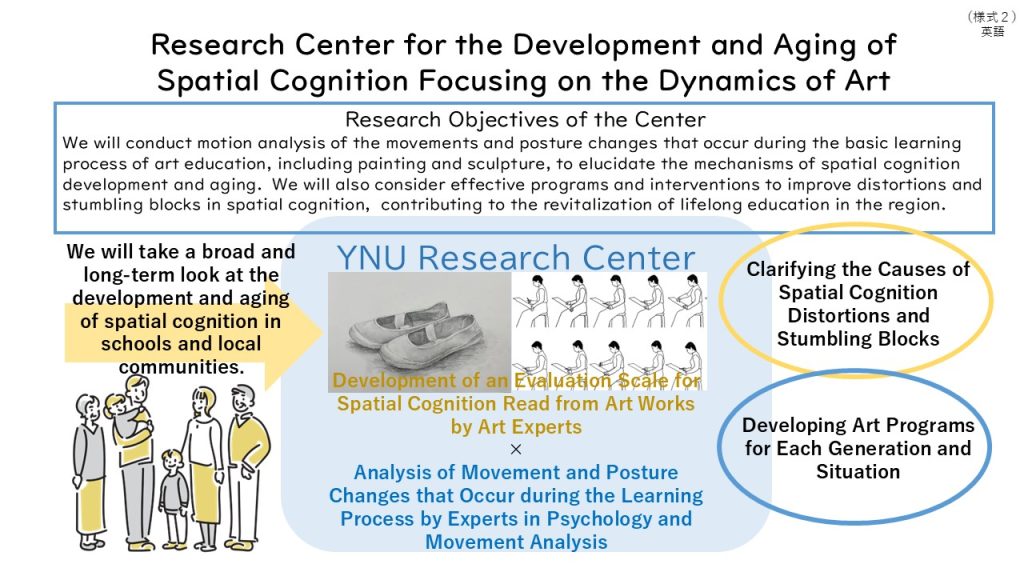Research Center for Difficulties in Artistic Spatial Cognition
Clarifying the causes of spatial cognition difficulties through AI motion analysis and verifying the effectiveness of interventions
The purpose of this center is to elucidate the mechanisms of special cognition development and aging, and to examine effective programs and intervention methods, primarily focusing on art education.
In recent years, AI technology has permeated every facet of our daily lives, raising concerns about the creativity and ethics of those leading the way. Within the art realm, worries persist about the impact of the abundance of information and media, such as virtual space, on the creativity and worth of artists. As a result, there is an urgent need to reexamine the essence of art and the meaning of human culture in the field of art education, including in schools. In particular, the “lack of reality” surrounding the creation of things is a notable issue.
Therefore, this study focuses on the inherent human dynamics of artistic activity and places emphasis on reexamining the starting point and development process of creativity. Through preliminary research, we found that spatial cognition, which forms the basis of creative endeavors, is deeply connected to the dynamics of art (Ito et al, 2025). This perspective ca be said to redefine the educational value of traditional visual arts such as painting and sculpture, which foster long-term relationships between materials, tools, and the body. However, existing educational research had several issues:1) there was no clear link between artistic mobility and creativity, 2) there were no objective indicators to show the development or difficulty of spatial cognition, and 3) intervention methods in art education had not been considered. It is also necessary to reconsider that spatial cognition skills cultivated through artistic activities are important skills for enriching social life for wide range of generations. Therefore, it is considered useful to consider the possibility of educational support that takes into account not only the cognitive development of children, but also the possibility of aging associated with aging.
The center aims to develop indicators for the development of spatial cognition and aging, and by accumulating objective evidence, develop arts programs suited to each generation.
In recent years, AI technology has permeated every facet of our daily lives, raising concerns about the creativity and ethics of those leading the way. Within the art realm, worries persist about the impact of the abundance of information and media, such as virtual space, on the creativity and worth of artists. As a result, there is an urgent need to reexamine the essence of art and the meaning of human culture in the field of art education, including in schools. In particular, the “lack of reality” surrounding the creation of things is a notable issue.
Therefore, this study focuses on the inherent human dynamics of artistic activity and places emphasis on reexamining the starting point and development process of creativity. Through preliminary research, we found that spatial cognition, which forms the basis of creative endeavors, is deeply connected to the dynamics of art (Ito et al, 2025). This perspective ca be said to redefine the educational value of traditional visual arts such as painting and sculpture, which foster long-term relationships between materials, tools, and the body. However, existing educational research had several issues:1) there was no clear link between artistic mobility and creativity, 2) there were no objective indicators to show the development or difficulty of spatial cognition, and 3) intervention methods in art education had not been considered. It is also necessary to reconsider that spatial cognition skills cultivated through artistic activities are important skills for enriching social life for wide range of generations. Therefore, it is considered useful to consider the possibility of educational support that takes into account not only the cognitive development of children, but also the possibility of aging associated with aging.
The center aims to develop indicators for the development of spatial cognition and aging, and by accumulating objective evidence, develop arts programs suited to each generation.

-
College of Education
-
College of Education
-
College of Education
-
College of Education
-
Odawara Junior CollegeKotomi TASHIRO
-
Tokai Universitykiyokatsu WATAHIKI

